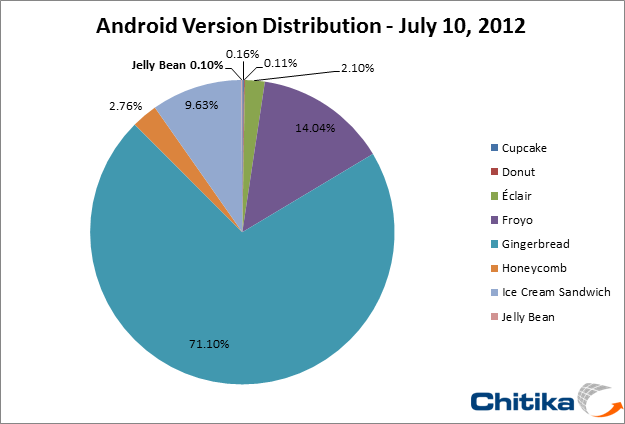Apple released iOS 6 Beta 3 to developers on Monday, July 16th, and, as with previous releases, there was a significant amount of interest from the software development community. Apple’s newest OS will include features such as a settings menu in the Maps app, allowing the user to control specifications including navigation voice volume and units of distance (miles or kilometers), among others to be unveiled. At Chitika Insights, our team looked to visualize this level of interest, based on iOS 6 Web traffic the first full day the OS was available. Additionally, we wanted to see how this compared to the activity surrounding Android Jelly Bean, which was made available to developers on July 9th. iOS had traditionally seen a great deal more developer activity and app development than Android, due to the heavier usage patterns of iOS users. However, this has slowly changed, and iOS and Android now nearly split the marketplace in half when it comes to usage share, as you can see in our real-time tracker.
To quantify this study, we took a sample composed of hundreds of millions of ad impressions from within the Chitika Ad network on July 10th and July 17th, 2012, respectively. A user agent analysis was then conducted on this sample of data to determine the rate of adoption for iOS 6 compared to other iOS versions available in the market, and a 24-hour rolling average was taken to determine usage rates. The same process was followed for Jelly Bean and Android. A table depicting the results of the July 17th iOS study can be seen below:
Since the release of iOS 6 Beta 2 to developers on June 25, it has held a small but consistent share of the iOS market, hovering around 0.09%. It is expected that the usage rates wouldn’t show a great increase, as those eligible to update to Beta 3 are the same group who could download Beta 2. The day following the Beta 3 release, though, we observed a nearly 10% increase in iOS 6 traffic to 0.11%. The timing of this spike coinciding with the release of Beta 3 indicates a significant adoption rate of the updated operating system, along with an increased interest in using the operating system for Web browsing.
Interestingly, Google’s release of Android Jelly Bean has been met with a nearly identical amount of enthusiasm, with usage rates the first full day following its release, hitting 0.10% of all Android traffic. The graph below shows overall usage share:
Comparing these data sets highlights the evolution of the mobile developer community. Android is now on near-even footing with iOS when it comes to attracting developer interest. However, the fragmentation issues prevalent in Android present a larger problem to developers looking to monetize their creations on the new operating system. Apple CEO Tim Cook was quick to point this out during his WWDC keynote address. However, as both releases develop, website publishers must be sure that their sites are optimized for viewing on the new operating system, with those early mobile adopters often representing the most valuable online consumers.


9 comments